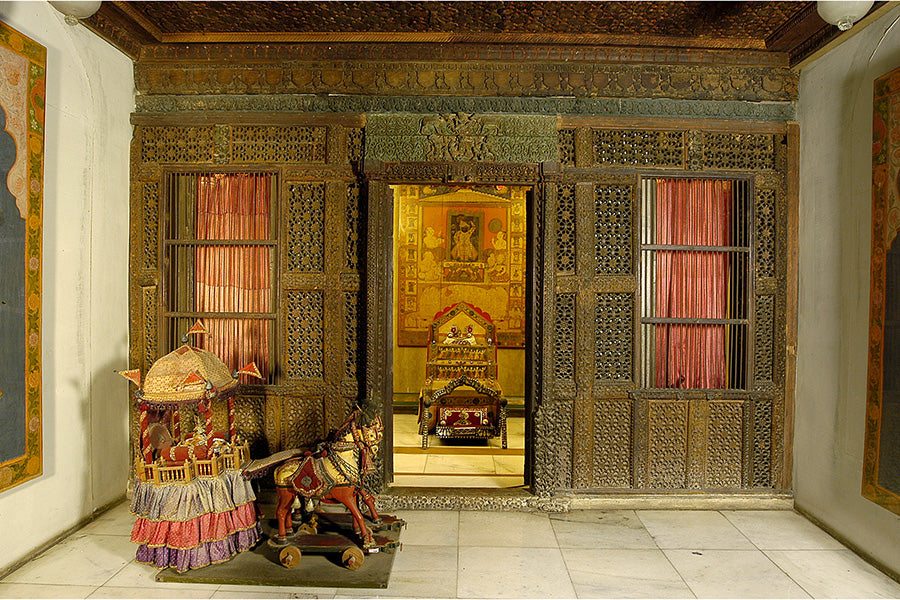
Calico Museum: India’s Finest Textile Museum
Across India one comes across an incredible diversity of beautiful traditional textiles for religious, ritual, ceremonial and domestic purposes as well as for attire. These textiles are hand-woven (including those that are hand-woven with hand-spun yarns); hand-embroidered; hand block-printed, hand-painted and tie-dyed by hand before dyeing. Their beauty -and symbolism of their motifs- speaks eloquently of Indian textiles being one of India’s most sought after exports throughout history to destinations spanning the Indonesian archipelago, the ancient Roman Empire, countries in Africa and Europe.

The inherently organic nature of textiles gives them a relatively short life span; thus textile scholars, designers and lovers to often study antique textiles from secondary sources. Yet, an extraordinary collection of Indian textiles awaits the seeker of traditional Indian textiles at The Calico Museum of Textiles, Ahmedabad, Gujarat, India, that is managed by the Sarabhai Foundation. Founded by Gautam Sarabhai and his sister Gira Sarabhai in 1949, the Calico Museum is regarded as the finest museum of Indian textiles in the world.
The textiles may be viewed only by a guided tour that takes a small group through the `Haveli’ that is the erstwhile residence of the Sarabhai family, home to sacred textiles, South Indian bronzes, miniature paintings and other artefacts, and the `Chauk’, comprising the many galleries of the Calico Museum. Part of the complex is graced with reconstructed finely carved wooden facades of traditional Gujarati mansions of the 18th and 19th centuries
 The galleries of the Calico Museum display an extraordinary collection of textiles spanning trade textiles from the 15th to the 19th centuries, textiles of the Mughal and provincial courts from the 17th to the 19th centuries, regional embroideries from different parts of India, beadwork from Gujarat, a variety of resist-dyed textiles, and Indian costumes.
The galleries of the Calico Museum display an extraordinary collection of textiles spanning trade textiles from the 15th to the 19th centuries, textiles of the Mughal and provincial courts from the 17th to the 19th centuries, regional embroideries from different parts of India, beadwork from Gujarat, a variety of resist-dyed textiles, and Indian costumes.
The displays cover painted, printed, embroidered, woven and resist-dyed textiles, from different time periods and different parts of the country thus offering a comprehensive representative history of surviving Indian textiles. Within each textile technique are variations. There are many rare textiles and masterpieces including a large Kalamkari (handpainted textile); a Mughal tent; a white on white trade textile from Bengal; a 27 feet long pattachitra; a pictorial pilgrimage map; a namavali textile (woven with the name of Lord Ram); two identical textiles of floral motifs one hand-painted and one embroidered; a ghaghra (skirt) with 400 panels; intricately patterned double ikat and tied-dye textiles and much more.
 After the tour, publications and cards may be viewed and purchased from the publications counter. If a researcher is looking for a particular textile, it would be prudent to mention the same to the tour guide beforehand so it may be possible for her to indicate it as there are hundreds of textiles on display. I was keen on seeing the sacred Vrindavani Vastra of which few sections remain worldwide, and she graciously indicated it during the tour. The Calico Museum is a gem and its tour is an experience of a lifetime. Find out more here
After the tour, publications and cards may be viewed and purchased from the publications counter. If a researcher is looking for a particular textile, it would be prudent to mention the same to the tour guide beforehand so it may be possible for her to indicate it as there are hundreds of textiles on display. I was keen on seeing the sacred Vrindavani Vastra of which few sections remain worldwide, and she graciously indicated it during the tour. The Calico Museum is a gem and its tour is an experience of a lifetime. Find out more here
Text by Brinda Gill, Images Courtesy Calico Museum - Sarabhai Foundation, Ahmedabad.
Join Polly Leonard on a once-in-a-lifetime tour of the textiles of India. More information here

1 comment
Last December we visited the Calico Textile Museum. It is a treasure trove, and it is very special in many ways, from the unique guided tours to the 100 % no photography policy … If one is interested in Indian textiles this is a MUST.